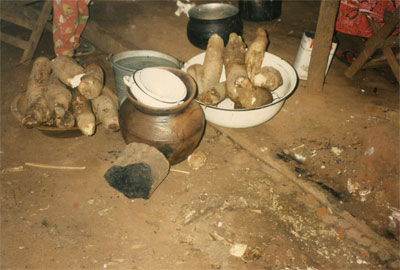Festivals

The Afahye or what is commonly called yam festival is an annual festival or celebration of thanksgiving, purification and blessings surrounding a family or a state ɔbosom. For the past year the ɔbosom has been working diligently, giving advice, helping people, maintaining balance, harmony in the family and community. The Afahye also provides a time of rest for the ɔbosom and signals the end of one year and the beginning of another year. The day which I celebrate my Afahye called Kwabena.
Other abosom may celebrate their yam festival on different days. The demand to get work to provide for the family and the pursuit of career may take us far away from the family and ɔbosom the Afahye is the time when family, friends, patrons, and those whom the obosom helped come back to give thanks, appreciation and reestablish ties and connections. The word Afahye is a compound word Afa which means half and Hye to celebrate. Why do we call it literally half celebration? It all has to do with agriculture and how the yam is consumed and planted. After the yam is harvested and ready for consumption it is not eaten whole but cut into three parts. The middle is use for human consumption, feeding the ɔbosom, Odomankoma, and the Nsamanfo. The other two ends are called the seed and what is used for planting the new yam crop. We do not eat the seeds which are used for planting. This ensures the next food cycle and provides food security for the future. When planting a crop of yam we purify ourselves before we go to the farm so that we get the blessings from the ɔbosom, Odomankoma, and the nsamanfo. This is to make sure we get enough rain and sunshine to grow the yams properly so that we may have a good harvest the next year. Why do we use the yam instead of any other crop? We were taught how to use this food in ancient times by the Atanɔ ɔbosom and the Afahye is a remembrance of the important occasion. It is at this time that we purify the obosom, the ɔbosomfoɔ, ɔkomfo, okyeame, family members, shrine members asking the obosom to bless us all. Six weeks prior to the set date of the yam festival, yam introduction was done signifying that the ɔbosom will eat new yam on that appointed day. The yam was presented to the ɔbosom, dirt from the yam is placed on the shrine, the head of the ɔbosomfoɔ, ɔkomfoɔ, okyeame, family members, and shrine members to notify the ɔbosom that the ɔbosomfoɔ and company will taboo the yams, will not eat, touch or have it in the home until after the ɔbosom eats the new yam.

Apoɔ
The Apoɔ celebration which last about thirteen days is particular and unique among the Bono people of Takyiman. The word is said to originate from the root poɔ to reject the thing concealed that has brought pain or suffering to the sunsum. According to E. V. Asihene the Apoɔ …”originated at Bono-Manso, the then capital of the Bono kingdom long before 1740 after a war.” He goes on to say: “their gods in ancient times advised the narration of grievances in public as a way to settle disputes.”
In Takyiman the Apoɔ like the Afahye (Yam festival) attracts many Bono nationalist and compatriot who has travelled far and wide. The seasonal celebration of the Apoɔ begins at the end of the harvest period around March or April before the vernal equinox. The celebration is a national one involving the Takyiman state surrounding Ta Mensa (the state obosom) who is the pivotal and focal point of the celebration, the Takyimanhene by no means plays an insignificant role. He and chiefs, queen mother, akyeame all participates in mock wrestling fight with past rival to bring about amicability. The appeasement of the ancestral spirits, asking for their blessings, fertility of future crops, the feeding of metal obosom Tunsun Kofi to open the way for all, and the running the street with Amoa a great obosom to clear all traps and cobweb that may have been set to snare the powers that be, this ritual is called Nnunsin-tuo. The participants dressed in all types of anthropomorphic costumes with festive drumming and singing disguising themselves to fool and eradicate chaos from their town.
